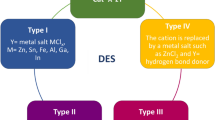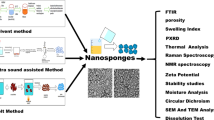Abstract
Solubility challenge for a poorly water-soluble drug gets further intensified when it is weakly ionic because the most common solubility enhancement technique, salt formation, becomes less feasible. Salt screening for such drugs often concludes with either a difficult to crystalize salt or an unstable salt, leading the scientists to explore other solubility enhancement technique like amorphous solid dispersions which is comparatively costlier, time-consuming and may require use of hazardous organic solvents. Present study evaluated in situ salification in polar protic solvents for dissolving poorly water-soluble drug Itraconazole which is weakly ionic and not very amenable to formation of stable inorganic salts. Through systematic selection of solvents, counterions and polymers, an amorphous solid dispersion of drug salt was obtained. In vitro characterizations with polarized light microscopy (PLM), modulated differential scanning calorimetry (mDSC), Fourier transform infrared spectroscopy (FTIR) and X-ray powder diffraction (XRD) confirmed the physical and chemical stability of the amorphous solid dispersion. In vivo pharmacokinetic study showed that the drug salt amorphous solid dispersion achieved 45 times higher plasma exposure compared to crystalline drug. This study provides one of the first data sets for the hypothesis that in situ drug salts can be utilized for manufacturing amorphous solid dispersions of weakly ionic drugs and leverages the solubility advantage of salts and amorphous state.












Similar content being viewed by others
References
Buckley ST, Frank KJ, Fricker G, Brandl M. Biopharmaceutical classification of poorly soluble drugs with respect to "enabling formulations". Eur J Pharm Sci. 2013;50:8–16.
Williams HD, Trevaskis NL, Charman SA, Shanker RM, Charman WN, Pouton CW, et al. Strategies to address low drug solubility in discovery and development. Pharmacol Rev. 2013;65:315–499.
Lee TW, Boersen NA, Hui HW, Chow SF, Wan KY, Chow AH. Delivery of poorly soluble compounds by amorphous solid dispersions. Curr Pharm Des. 2014;20:303–24.
Fong SY, Brandl M, Bauer-Brandl A. Phospholipid-based solid drug formulations for oral bioavailability enhancement: a meta-analysis. Eur J Pharm Sci. 2015;80:89–110.
Leone F, Cavalli R. Drug nanosuspensions: a ZIP tool between traditional and innovative pharmaceutical formulations. Expert Opin Drug Deliv. 2015;12:1607–25.
Zand D, Templeton AC, Marinaro W, Rumondor ACF, Keisisoglou F, Deursch B, et al. Leveraging solid state forms and physicochemical properties for early clinical formulation efforts: opportunities and challenges during Telcagepant liquid capsule development. In: Tempelton AC, Byrn SR, Haskell RJ, Prisinzano TE, editors. Discovering & developing molecules with optimal drug-like properties. New York: Springer; 2015. p. 487–92.
Bighley LD, Berge SM, Monkhouse DC. Salt forms of drugs and absorption. In: Swarbrick J, Boylan J, editors. Encyclopaedia of pharmaceutical technology. New York: Dekker; 1996. p. 453–99.
Anderson BD, Flora KP. Preparation of water-soluble compounds through salt formation. In: Wermuth CG, editor. The practice of medicinal chemistry. London: Academic; 1996. p. 739–54.
Serajuddin ATM. Salt formation to improve drug solubility. Adv Drug Deliv Rev. 2007;59:603–16.
Teaf CM, Garber MM, Kuperberg JM. Properties and effects of solvents & solvent- like chemicals. In: Roberts SM, James RC, Williams PL, editors. Principles of toxicology: environmental & industrial applications. New Jersey: John Wiley & Sons; 2015. p. 339–41.
Remenar JF, Morissette SL, Peterson ML, Moulton B, MacPhee JM, Guzmán HR, et al. Crystal engineering of novel cocrystals of a triazole drug with 1,4-dicarboxylic acids. J Am Chem Soc. 2003;125:8456–7.
Tao T, Zhao Y, Wu J, Zhou B. Preparation and evaluation of Itraconazole dihydrochloride for the solubility and dissolution rate enhancement. Int J Pharm. 2009;367:109–14.
Shevchenko A, Bimbo LM, Miroshnyk I, Haarala J, Jelínková K, Syrjänen K, et al. A new cocrystal and salts of itraconazole: comparison of solid-state properties, stability and dissolution behaviour. Int J Pharm. 2012;436:403–9.
Tarsaa PB, Towlerb CS, Woollamb G, Berghausenc J. The influence of aqueous content in small scale salt screening—improving hit rate for weakly basic, low solubility drugs. Eur J Pharm Sci. 2010;41:23–30.
Gilis PMV, De Conde VFV, Vandecruys RPG, inventors; Janssen Pharmaceutica Nv, assignee. Beads having a core coated with an antifungal and a polymer. United States patent 5633015. 1997. May 27.
Henderson RK, Jiménez-González C, Constable DJC, Alston SR, Inglis G, Fisher G, et al. Expanding GSK’s solvent selection guide – embedding sustainability into solvent selection starting at medicinal chemistry. Green Chem. 2011;13:854–62.
Prat D, Pardigon O, Flemming H, Letestu S, Ducandas V, Isnard P, et al. Sanofi’s solvent selection guide: a step toward more sustainable processes. Org Process Res Dev. 2013;17:1517–25.
Alfonsi K, Colberg J, Dunn PJ, Fevig T, Jennings S, Johnson TA, et al. Green chemistry tools to influence a medicinal chemistry and research chemistry based organisation. Green Chem. 2008;10:31–6.
Garrido G, Rafols C, Bosch E. Acidity constants in methanol/water mixtures of polycarboxylic acids used in drug salt preparations—potentiometric determination of aqueous pKa values of quetiapine formulated as hemifumarate. Eur J Pharm Sci. 2006;28:118–27.
Rived F, Canals I, Bosch E, Roses M. Acidity in methanol–water. Anal Chim Acta. 2001;439:315–33.
Anslyn EV, Dougherty DA. Acid-base chemistry. In: Murdzek J, editor. Modern physical organic chemistry. California: University Science Books; 2006. p. 272.
Prat D, Hayler J, Wells A. A survey of solvent selection guides. Green Chem. 2014;16:4546–51.
Serajuddin ATM, Pudipeddi M. Salt-selection strategies. In: Stahl PH, Wermuth CG, editors. Handbook of pharmaceutical salts: properties, selection and use. Weinheim: Wiley; 2002. p. 135–60.
Meng F, Dave V, Chauhan H. Qualitative and quantitative methods to determine miscibility in amorphous drug-polymer systems. Eur J Pharm Sci. 2015;77:106–11.
Pine SH. The scope of nucleophilic substitution. In: Organic chemistry. New Delhi: Tata McGraw-Hill publishing company Ltd.; 2008. p.352.
Brown WH, Iverson BL, Anslyn E, Foote CS. Alcohols. In: Organic chemistry. USA: Brooks/Cole; 2013. p. 405.
Inkmann E, Holzgrabe U. 1H and 13C nuclear magnetic resonance studies of the sites of protonation in itraconazole and fluconazole. J Pharm Biomed Anal. 1999;20:297–307.
Miller DA, Gil M. Spray-Drying technology. In: Williams III RO, Watts AB, Miller DA, editors. Formulating poorly water soluble drug. New York: Springer; 2012. p. 394.
Huang L, Dong J. Formulation strategies and practice used for drug candidates with water-insoluble properties for toxicology, biology and pharmacology studies in discovery support. In: Liu R, editor. Water-insoluble drug formulation. USA: CRC press; 2008. p. 115.
Loftsson T. Complex formation. In: Felton L, editor. Remington essentials of pharmaceutics. London: Pharmaceutical press; 2013. p. 325–6.
Miller DA, McGinity JW, Williams RO III. Solid dispersion technologies. In: Williams III RO, Taft DR, JT MC, editors. Advanced drug formulation design to optimise therapeutic outcome. Florida: CRC press; 2008. p. 475.
Parikh T, Sandhu HK, Talele TT, Serajuddin TM. Characterization of solid dispersion of Itraconazole prepared by solubilization in concentrated aqueous solutions of weak organic acids and drying. Pharm Res. 2016;33:1456–71.
Chauhan H, Hui-gu C, Atef E. Correlating the behavior of polymers in solution as precipitation inhibitor to its amorphous stabilization ability in solid dispersions. J Pharm Sci. 2013;102:1924–35.
Towler CS, Li T, Wikström H, Remick DM, Sanchez-Felix MV, Taylor LS. An investigation into the influence of counterion on the properties of some amorphous organic salts. Mol Pharm. 2008;5:946–55.
Nielsen LH, Gordon S, Holm R, Selen A, Rades T, Müllertz A. Preparation of an amorphous sodium furosemide salt improves solubility and dissolution rate and leads to a faster Tmax after oral dosing to rats. Eur J Pharm Sci. 2013;85:945–51.
Lee SH, Bae JH, Park Y, Adhikari BR, Mao C, Kim D, et al. Sulfonic acid salts of donepezil and stabilization of amorphous donepezil via formation of amorphous salts. Cryst Growth Des. 2015;15:3123–30.
Stoimenovski J, MacFarlane DR, Bica K, Rogers RD. Crystalline vs. ionic liquid salt forms of active pharmaceutical ingredients: a position paper. Pharm Res. 2010;27:521–6.
Author information
Authors and Affiliations
Corresponding author
Rights and permissions
About this article
Cite this article
Nair, R., Lamare, I., Tiwari, N.K. et al. In Situ Salification in Polar Solvents: a Paradigm for Enabling Drug Delivery of Weakly Ionic Drugs as Amorphous Solid Dispersion. AAPS PharmSciTech 19, 326–337 (2018). https://doi.org/10.1208/s12249-017-0808-z
Received:
Accepted:
Published:
Issue Date:
DOI: https://doi.org/10.1208/s12249-017-0808-z




